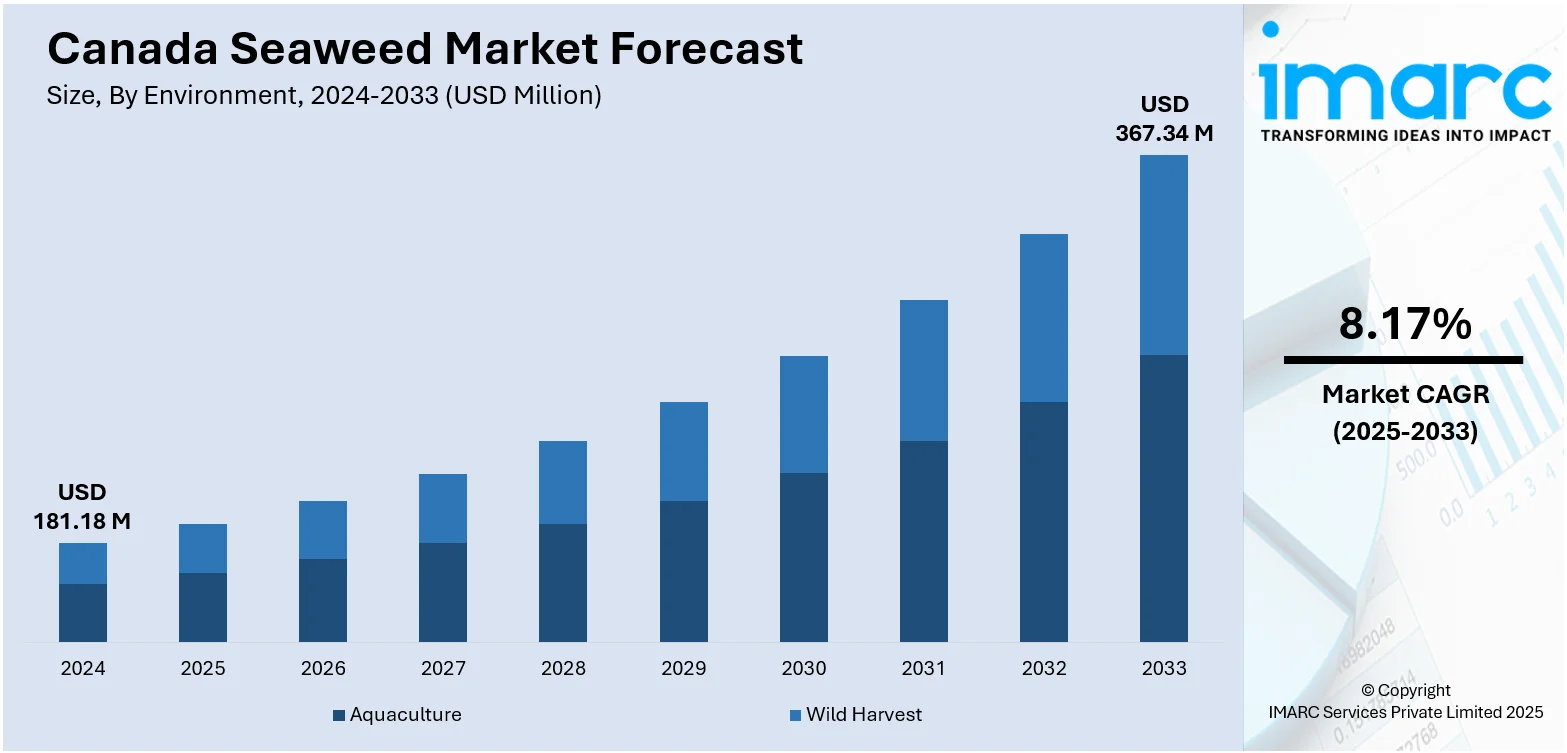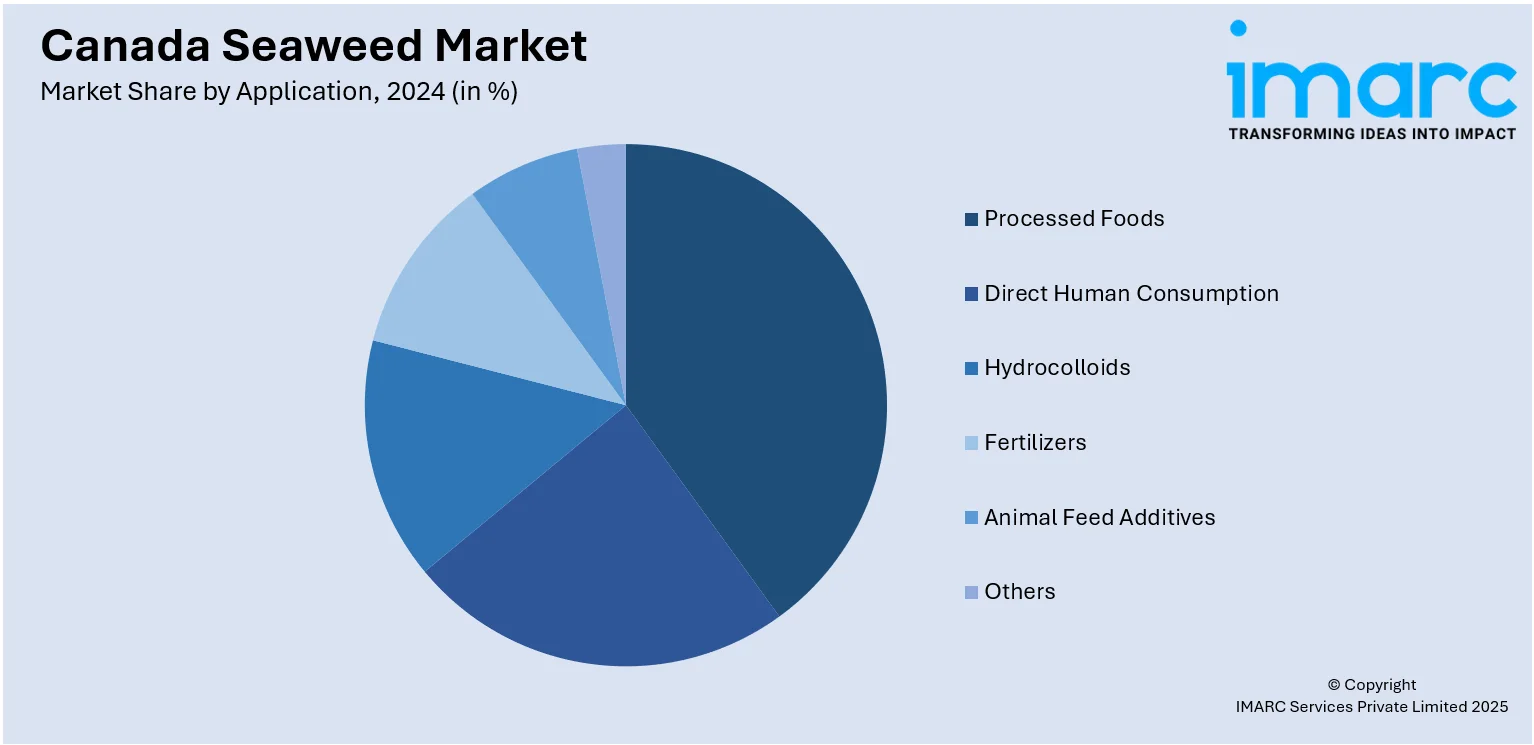
Canada Seaweed Market Size, Share, Trends and Forecast by Environment, Product, Application, and Region, 2025-2033
Canada Seaweed Market Overview:
The Canada seaweed market size reached USD 181.18 Million in 2024. Looking forward, IMARC Group expects the market to reach USD 367.34 Million by 2033, exhibiting a growth rate (CAGR) of 8.17% during 2025-2033. The market is driven by increasing demand for biodegradable seaweed-based packaging that aligns with Canada’s sustainability mandates. Nutraceutical producers are utilizing bioactive compounds from seaweed to develop functional food products addressing consumer interest in plant-based health solutions. Expanding use of seaweed-derived biostimulants in organic farming is further augmenting the Canada seaweed market share.
|
Report Attribute
|
Key Statistics
|
|---|---|
|
Base Year
|
2024 |
|
Forecast Years
|
2025-2033
|
|
Historical Years
|
2019-2024
|
| Market Size in 2024 | USD 181.18 Million |
| Market Forecast in 2033 | USD 367.34 Million |
| Market Growth Rate 2025-2033 | 8.17% |
Canada Seaweed Market Trends:
Focus on Sustainable Packaging and Circular Economy
Canada’s environmental policy frameworks increasingly emphasize plastic waste reduction and circular economy strategies, leading to a growing interest in seaweed-derived packaging. Companies specializing in biomaterials are leveraging the properties of seaweed to produce biodegradable films, containers, and coatings. Collaboration between Canadian research institutions, biotechnology firms, and packaging producers is driving innovation in this field. Through funding received under the Pan Canadian AI Strategy (PCAIS) Program, Canada’s Ocean Supercluster is contributing USD 353,000 to the AI-Driven Sensor for Seaweed Measurement Project, which has a total project value of nearly USD 1.16 million. Seaweed’s abundance and regenerative harvesting cycles provide a competitive advantage for brands positioning eco-friendly products. Pilot projects involving retailers and consumer brands are already testing seaweed-based solutions for product packaging. Supply chains are steadily formalizing to meet material certification standards and retailer specifications. Financial incentives through grants and environmental innovation funds are supporting commercialization efforts, positioning Canadian enterprises at the forefront of sustainable packaging. Educational outreach to consumers is also reinforcing demand, as awareness rises regarding single-use plastics and their ecological impact. As market frameworks for environmentally responsible packaging mature, bio-based alternatives are expected to become mainstream options across multiple industries, strengthening Canada seaweed market growth.

To get more information on this market, Request Sample
Agricultural Innovation and Organic Farming Inputs
In Canada’s agricultural sector, seaweed-based biostimulants are steadily gaining market acceptance as natural solutions to improve crop yield and resilience. Organic and regenerative farming operations, particularly those located in coastal provinces, are incorporating seaweed extracts into fertilization and soil amendment programs. These bioactive products contribute to better root growth, enhanced nutrient absorption, and increased tolerance to environmental stressors. Seaweed applications also support sustainable livestock feed practices by reducing methane emissions when integrated into ruminant diets, a growing area of interest for environmentally conscious agricultural producers. Partnerships between Canadian seaweed processors and agricultural cooperatives are fostering expanded access to these inputs. Universities specializing in agricultural sciences are conducting field trials on crop-specific efficacy, providing validated data that supports broader adoption. In February 2025, the Government of Canada announced over USD 1.1 million in funding to support innovations in British Columbia’s blue economy, with a significant focus on developing the seaweed sector. Through Pacific Economic Development Canada (PacifiCan), USD 881,600 was allocated to North Island College to establish the Seaweed Innovation Hub (SIH). Certification alignment with organic agricultural standards ensures that farmers can use these inputs within certified organic production systems. As sustainability requirements grow across Canadian agriculture, natural bio-based solutions derived from marine ecosystems are becoming strategic priorities for farms seeking both productivity and environmental responsibility.
Canada Seaweed Market Segmentation:
IMARC Group provides an analysis of the key trends in each segment of the market, along with forecasts at the country and regional levels for 2025-2033. Our report has categorized the market based on environment, product, and application.
Environment Insights:
- Aquaculture
- Wild Harvest
The report has provided a detailed breakup and analysis of the market based on the environment. This includes aquaculture and wild harvest.
Product Insights:
- Red
- Brown
- Green
The report has provided a detailed breakup and analysis of the market based on the product. This includes red, brown, and green.
Application Insights:

- Processed Foods
- Direct Human Consumption
- Hydrocolloids
- Fertilizers
- Animal Feed Additives
- Others
The report has provided a detailed breakup and analysis of the market based on the application. This includes processed foods, direct human consumption, hydrocolloids, fertilizers, animal feed additives, and others.
Regional Insights:
- Ontario
- Quebec
- Alberta
- British Columbia
- Others
The report also covers all major regional markets. These are Ontario, Quebec, Alberta, British Columbia, and others.
Competitive Landscape:
The market research report has also provided a comprehensive analysis of the competitive landscape. Competitive analysis such as market structure, key player positioning, top winning strategies, competitive dashboard, and company evaluation quadrant has been covered in the report. Also, detailed profiles of all major companies have been provided.
Canada Seaweed Market News:
- On November 21, 2024, Cascadia Seaweed, based in British Columbia, announced the first close of its Series A funding round, raising CAD 4 million (USD 2.9 million) to scale production and expand its line of kelp-based agricultural products. The funding will support construction of a commercial-scale seaweed biorefinery on Canada’s West Coast and boost biomass output for products like liquid kelp extracts, biostimulants, and livestock supplements.
Canada Seaweed Market Report Coverage:
| Report Features | Details |
|---|---|
| Base Year of the Analysis | 2024 |
| Historical Period | 2019-2024 |
| Forecast Period | 2025-2033 |
| Units | Million USD |
| Scope of the Report |
Exploration of Historical Trends and Market Outlook, Industry Catalysts and Challenges, Segment-Wise Historical and Future Market Assessment:
|
| Environments Covered | Aquaculture, Wild Harvest |
| Products Covered | Red, Brown, Green |
| Applications Covered | Processed Foods, Direct Human Consumption, Hydrocolloids, Fertilizers, Animal Feed Additives, Others |
| Regions Covered | Ontario, Quebec, Alberta, British Columbia,Others |
| Customization Scope | 10% Free Customization |
| Post-Sale Analyst Support | 10-12 Weeks |
| Delivery Format | PDF and Excel through Email (We can also provide the editable version of the report in PPT/Word format on special request) |
Key Questions Answered in This Report:
- How has the Canada seaweed market performed so far and how will it perform in the coming years?
- What is the breakup of the Canada seaweed market on the basis of environment?
- What is the breakup of the Canada seaweed market on the basis of product?
- What is the breakup of the Canada seaweed market on the basis of application?
- What is the breakup of the Canada seaweed market on the basis of region?
- What are the various stages in the value chain of the Canada seaweed market?
- What are the key driving factors and challenges in the Canada seaweed market?
- What is the structure of the Canada seaweed market and who are the key players?
- What is the degree of competition in the Canada seaweed market?
Key Benefits for Stakeholders:
- IMARC’s industry report offers a comprehensive quantitative analysis of various market segments, historical and current market trends, market forecasts, and dynamics of the Canada seaweed market from 2019-2033.
- The research report provides the latest information on the market drivers, challenges, and opportunities in the Canada seaweed market.
- Porter's five forces analysis assist stakeholders in assessing the impact of new entrants, competitive rivalry, supplier power, buyer power, and the threat of substitution. It helps stakeholders to analyze the level of competition within the Canada seaweed industry and its attractiveness.
- Competitive landscape allows stakeholders to understand their competitive environment and provides an insight into the current positions of key players in the market.
Need more help?
- Speak to our experienced analysts for insights on the current market scenarios.
- Include additional segments and countries to customize the report as per your requirement.
- Gain an unparalleled competitive advantage in your domain by understanding how to utilize the report and positively impacting your operations and revenue.
- For further assistance, please connect with our analysts.
 Request Customization
Request Customization
 Speak to an Analyst
Speak to an Analyst
 Request Brochure
Request Brochure
 Inquire Before Buying
Inquire Before Buying




.webp)




.webp)












